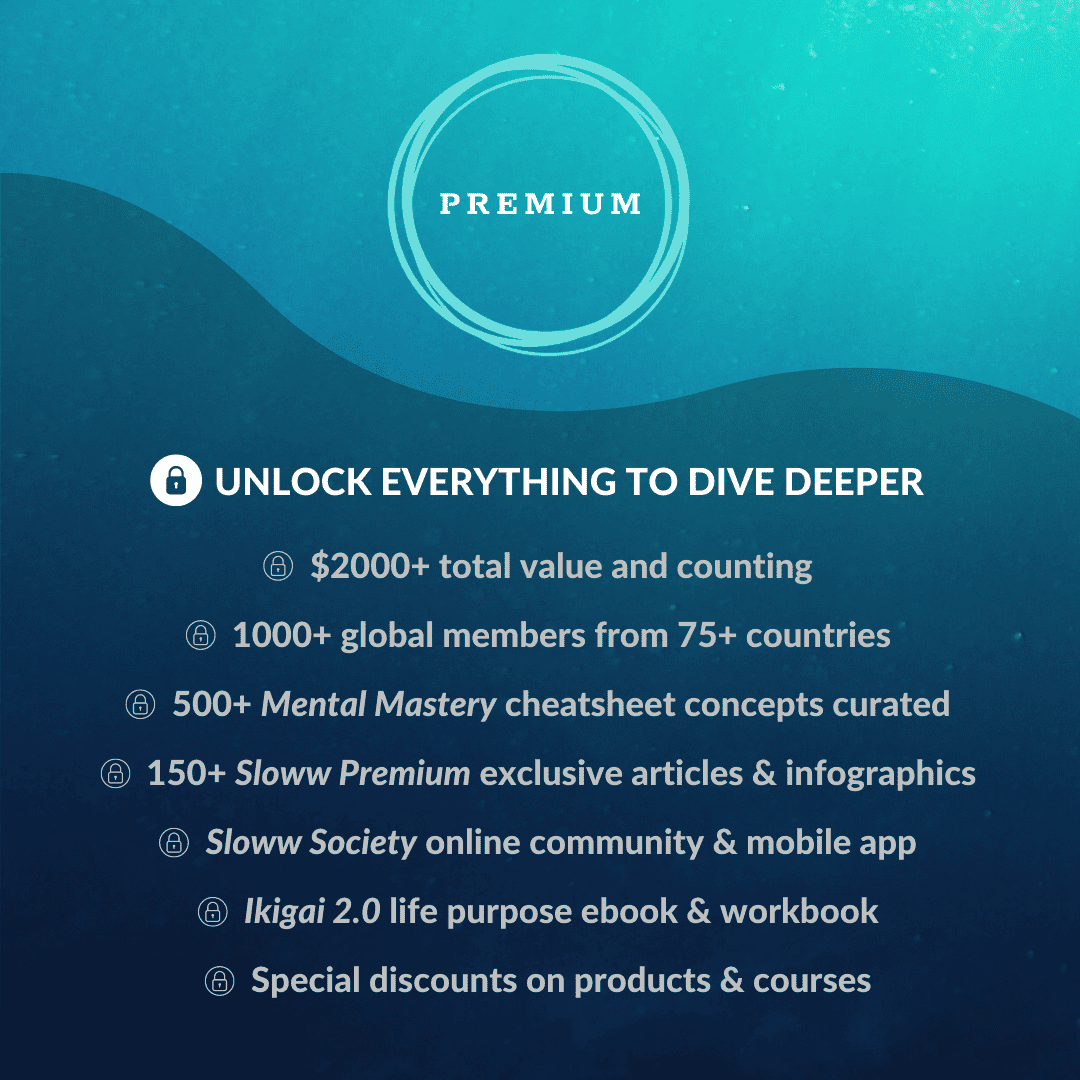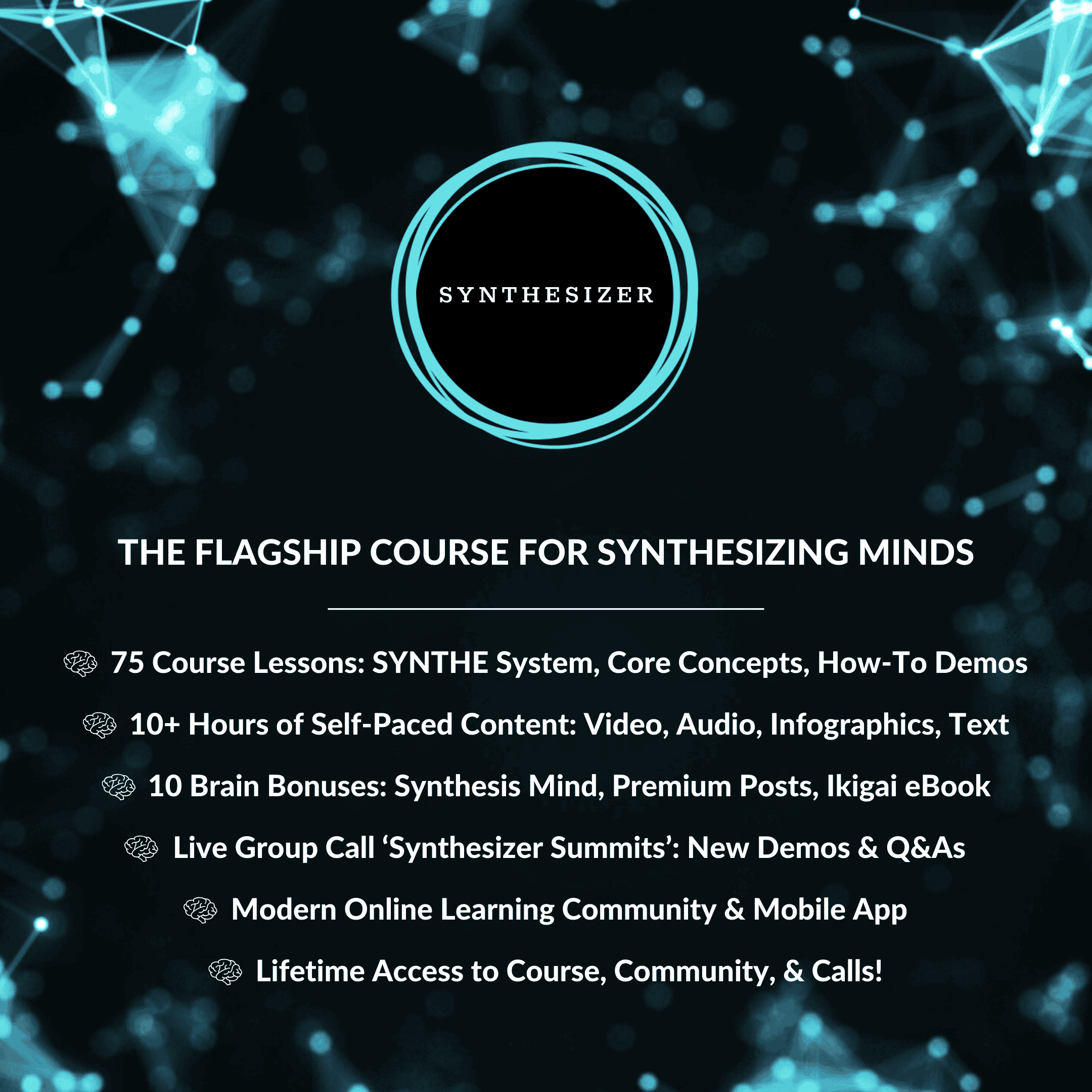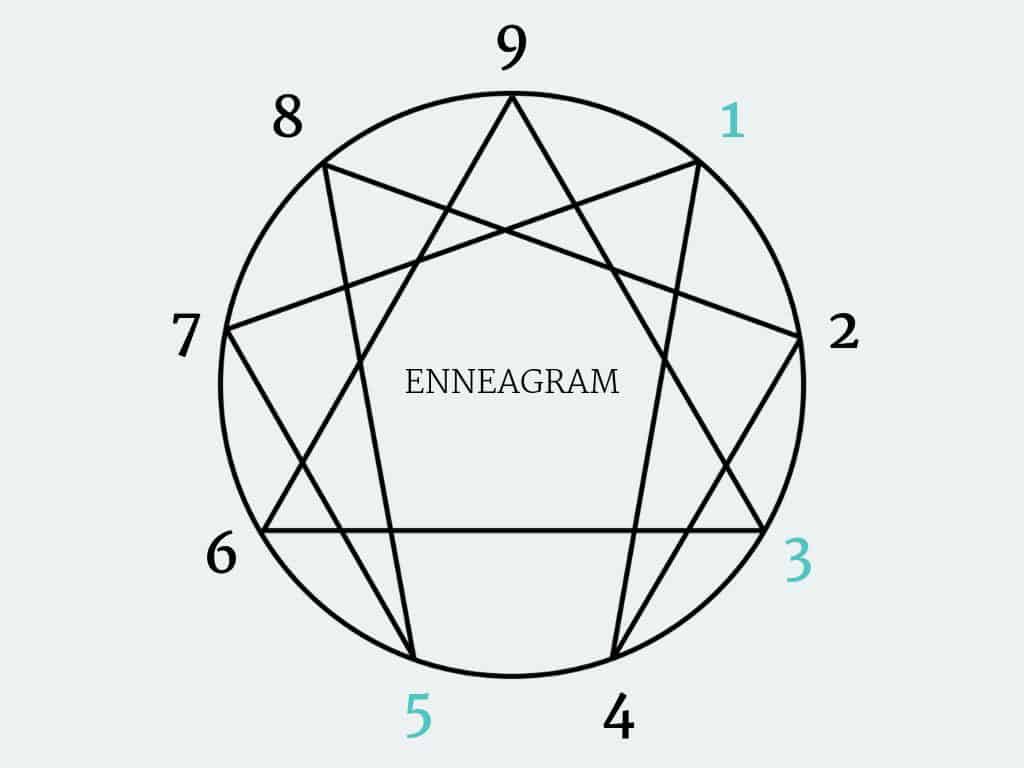
Looking for the full book summary? Personality meets Spirituality in “The Wisdom of the Enneagram” by Riso & Hudson (Book Summary)
This post dives deeper into Enneagram types 3, 5, and 1. Why those three types out of the nine?
Because I feel like I’m stuck between all three of them. Or, maybe I’m simply a conglomeration of all three Enneagram types.
In my opinion, there are a few noteworthy differences between MBTI (Myers-Briggs Type Indicator) and Enneagram:
- I’ve always received one clear answer for MBTI (my personality type is INTJ), but I have a mix of three types for Enneagram.
- I feel like MBTI is more positive and focused on strengths; Enneagram seems more focused on pitfalls and weaknesses. I’m still a novice when it comes to these type tools, so maybe this is an unfair initial impression.
- MBTI seems to stick to the psychological; Enneagram combines the spiritual with the psychological which I find incredibly enlightening.
All content in this post—except for a couple mentions of free online Enneagram tests—is from the book The Wisdom of the Enneagram: The Complete Guide to Psychological and Spiritual Growth for the Nine Personality Types (Amazon) by Don Richard Riso and Russ Hudson.
Quick Housekeeping: All quotes are from the authors unless otherwise stated. I’ve added emphasis to some quotes throughout this post in bold. To show where I personally resonate the most with each type, I’ve also highlighted some content in color.
Post Contents: Click a link below to jump to a section within this post
- Enneagram Type Tests (QUEST, TAS, RHETI, & Free Online Tests)
- Enneagram Comparison for Types 3, 5, & 1 (Main Themes, Identifications, Fears, Desires, & More)
- Enneagram Type 3 Summary (The Achiever)
- Enneagram Type 5 Summary (The Investigator)
- Enneagram Type 1 Summary (The Reformer)
- Overall Results Self-Analysis
Enneagram Type Tests from The Wisdom of the Enneagram Book by Riso & Hudson
Enneagram Type Test #1
The first “test” in the book includes reading brief descriptions of the nine types to determine which ones resonate the most. This should rule out at least a few types, and directionally point you in the right direction. After reading all nine descriptions, I was able to narrow it down to five possible types.
Here were my results:
- Type 1: The Reformer
- Type 3: The Achiever
- Type 4: The Individualist
- Type 5: The Investigator
- Type 6: The Loyalist
Enneagram Type Test #2: Riso-Hudson QUEST (Quick Enneagram Sorting Test)
The goal of this next test is to help narrow down your basic type in less than 5 minutes with 70% accuracy. You should be able to get your top 2-3 type possibilities.
The test consists of reading a few paragraphs from a couple groups and identifying which ones resonate the most.
I selected:
- Group 1:
- Gut Answer: A
- Secondary Answer: B
- Group 2:
- Gut Answer: Z
- Secondary Answer: Y
My Results:
- Most Likely Types:
- AZ: 3 Achiever (adaptable, ambitious, image-conscious)
- BZ: 5 Investigator (perceptive, innovative, detached)
- Other Possible Types:
- AY: 8 Challenger (self-confident, decisive, domineering)
- BY: 4 Individualist (intuitive, aesthetic, self-absorbed)
Enneagram Type Test #3: Riso-Hudson TAS (Type Attitude Sorter)
Taking it a step further, I did the Riso-Hudson TAS (Type Attitude Sorter) with the goal of helping you check your findings. There’s a TAS for each type, and each one is 15 statements.
I took each type test once and then went back and took the tests for my top three scores a second time. That’s why you’ll see two scores for types 3, 5, and 1 below.
My Results:
- Type 3: 59-60 (most likely to misidentify as 5, 1, 8 — 8, 7, 9 are most likely to misidentify as 3)
- Type 5: 59-59 (most likely to misidentify as 4, 6, 1 — 9, 3, 1 are most likely to misidentify as 5)
- Type 1: 54-56 (most likely to misidentify as 5, 4, 6 — 3, 6, 7 are most likely to misidentify as 1)
- Type 8: 47
- Type 6: 43
- Type 4: 42
Notice how close the scores are for Types 3 & 5. And, Type 1 isn’t far behind.
Additional Enneagram Tests:
Paid Test:
- If you want to go even further, you can take the paid Riso-Hudson Enneagram Type Indicator (RHETI) at EnneagramInstitute.com. It’s 144 paired statements and takes 45 minutes to complete (80% accuracy). I haven’t taken this one yet.
Free Online Tests: I’ve tried the following:
- Eclectic Energies:
- This test confirmed my top three types, but it had them in a different order: Type 1, Type 5, and then Type 3.
- It typed me as a 1w9 followed by a 5w6. Interestingly, 3w4 fell to 8th place.
- Overall, this free test seemed fairly accurate.
- 9 Types:
- I took this test twice, and it typed me primarily as a Type 5.
- I don’t feel like I got much from this free test.
Enneagram Comparison for Types 3, 5, & 1 from The Wisdom of the Enneagram Book by Riso & Hudson
My three types are each in a different triad (Instinctive, Feeling, Thinking) and different Hornevian Groups (Assertives, Compliants, Withdrawns), but interestingly, they are all in the 1-3-5 harmonic pattern (the competency group).
This section of the summary will compare the three types in a variety of different ways. To show where I resonate the most with each type, I’ve highlighted some content in color.
Main Themes of the Competency Group: Cut off feelings and solve problems logically
- Enneagram Type 3: Emphasizes being efficient, capable, and outstanding. They focus on goals, being pragmatic, and knowing how to present self. Manages feelings by repression and keeping attention on tasks, staying active. Achievement offsets painful feelings. They look to others for feeling cues. Relation to systems: Threes want to work with the system. But they also like being outside of it—bending rules and finding shortcuts. “There’s an efficient solution to this—we just need to get to work.”
- Enneagram Type 5: Emphasizes being the expert and having deep information. They focus on the process, objective facts, and maintaining clarity and detachment. Manages feelings by splitting off and abstracting feelings, they stay preoccupied and cerebral, as if their feelings were happening to someone else. Relation to systems: Fives reject the system and want to work on their own, outside of it. They have little patience with rules or procedures. “There are a number of hidden issues here: let me think about this.”
- Enneagram Type 1: Emphasizes being correct, organized, and sensible. They focus on standards, improving themselves, and knowing the rules. Manages feelings by repression and denial. Feelings are channeled into activity, getting things done perfectly. Feelings are also held as physical rigidity in the body. Relation to systems: Ones want to work with the system. They try to be a “good boy or girl” and are irritated with people who disregard the rules. “I’m sure we can solve this like sensible, mature adults.”
Core Identifications:
- Enneagram Type 3: Identifies powerfully with a self-image developed in response to what they perceive as admiration by others. Resists recognizing feelings of emptiness, own self-rejection. To sustain the self-image of being; admirable, desirable, attractive, outstanding, well-adjusted, effective, having “unlimited potential.”
- Enneagram Type 5: Identifies powerfully with sense of being a detached, outside observer of the world—not part of it. Resists recognizing physical presence and state, feelings and needs. To sustain the self-image of being: perceptive, “smart,” curious, self-contained, insightful, unusual, alert, objective.
- Enneagram Type 1: Identifies powerfully with the superego, with the capacity to evaluate, compare, measure, and discern experiences or things. Resists recognizing anger-based tension. To sustain the self-image of being: reasonable, sensible, objective, moderate, prudent, moral, “good,” rational.
Basic Fears:
- Enneagram Type 3: Fear of being worthless or without inherent value. Without value apart from their achievements. (Red Flag Fear: That they are failing, that their claims are empty and fraudulent.)
- Enneagram Type 5: Fear of being useless, incapable, or incompetent. Of being helpless, overwhelmed. (Red Flag Fear: That they are never going to find a place in the world or with people.)
- Enneagram Type 1: Fear of being bad, corrupt, evil, or defective. (Red Flag Fear: That their ideals are actually wrong and counterproductive.)
Basic Desires & Distortions:
- Enneagram Type 3: The desire to be valuable. To feel worthwhile, accepted, and desirable. (Deteriorates into chasing after success; Wake-up call: Beginning to drive themselves for status and attention)
- Enneagram Type 5: The desire to be competent. To be capable. (Deteriorates into useless specialization; Wake-up call: Withdrawing from reality into concepts and mental worlds)
- Enneagram Type 1: The desire to have integrity. To be good, virtuous, in balance. (Deteriorates into critical perfectionism; Wake-up call: Feeling a sense of personal obligation to fix everything themselves)
Invitations to Abundance:
- Enneagram Invitation 3: To develop yourself and set an example for others. Remember that it is your true nature to take pleasure in your existence and to esteem and value others.
- Enneagram Invitation 5: To observe yourself and others without judgment or expectations. Remember that it is your true nature to be engaged with reality, contemplating the infinite riches of the world.
- Enneagram Invitation 1: To live for a Higher Purpose. Remembering that it is your true nature to be wise and discerning.
I will become present to my life only when:
- Enneagram Type 3: I have accomplished enough to feel successful and worthwhile. When I have all the admiration and attention I want and feel completely outstanding, then I’ll show up.
- Enneagram Type 5: I feel completely confident and capable of dealing with the world. When I have completely understood and mastered everything I might need to know in life, then I’ll show up.
- Enneagram Type 1: I have attained complete balance and integrity, make no mistakes, and have everything in my world sensibly organized. When I have achieved perfection, then I’ll show up.
The Marching Orders:
- Enneagram Type 3: “You are good or okay if you do something valuable.” “You are good or okay as long as you are successful and others think well of you.” (Contradiction: What makes you think a particular activity makes you valuable? Why do you have to do something to feel valuable? How much do you have to accomplish to be worthwhile? Threes are often overachievers who feel empty inside.)
- Enneagram Type 5: “You are good or okay if you have thoroughly mastered something.” (Contradiction: How do know when you have fully mastered something? When are you finished? How does what you are mastering relate to the real needs in your life? Fives work on a subject or skill for many years and still lack self-confidence.)
- Enneagram Type 1: “You are good or okay if you do what is right.” (Contradiction: Sounds reasonable, but how do you know what is right”? Who says so? Is your set of standards objective or subjective? Where did these ideas come from? Ones struggle to be good, but they are never good enough for their own superegos.)
Healing Attitudes:
- Enneagram Type 3: Maybe I don’t have to be the best. Maybe people will accept me just the way I am. Maybe others’ opinions of me aren’t so important.
- Enneagram Type 5: Maybe I can trust people and let them know what I need. Maybe I can live happily in the world. Maybe my future will be okay.
- Enneagram Type 1: Maybe others are right. Maybe someone else has a better idea. Maybe others will learn for themselves. Maybe I’ve done all that can be done.
Enneagram Type 3 Summary: The Achiever
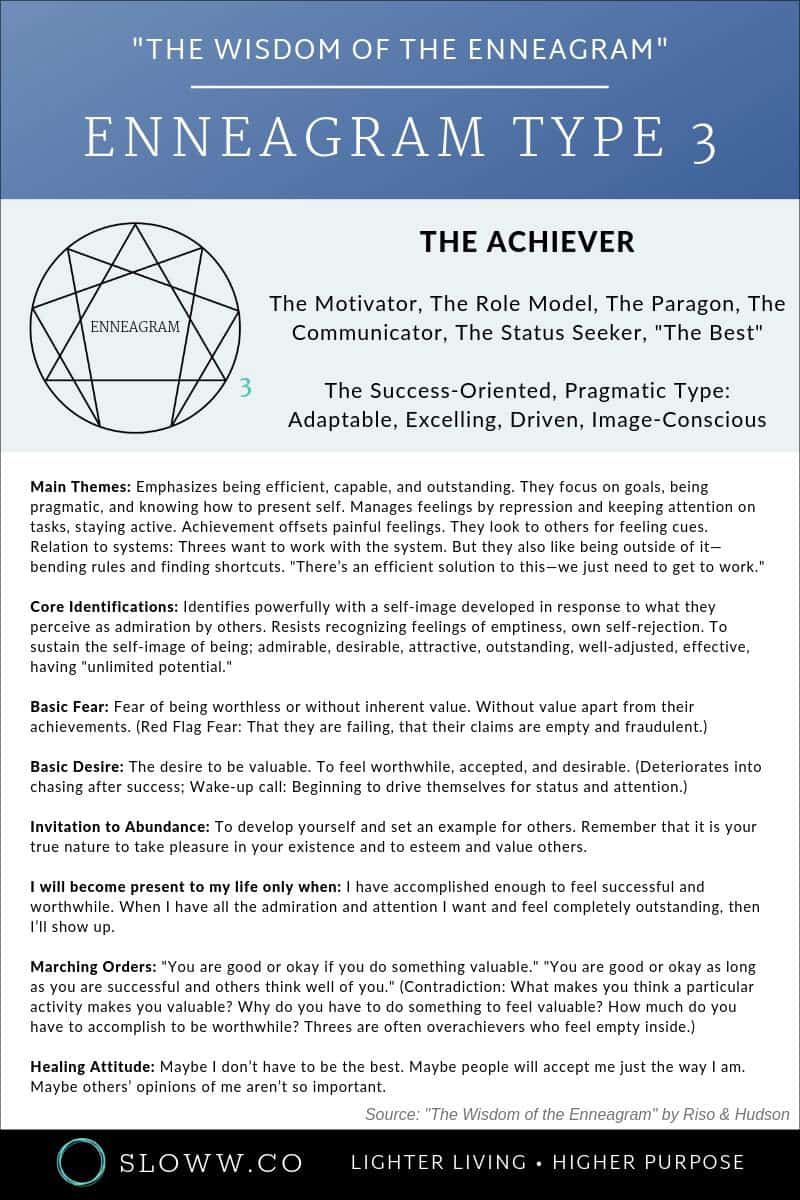
- The Motivator, The Role Model, The Paragon, The Communicator, The Status Seeker, “The Best”
- The Success-oriented, pragmatic type: adaptable, excelling, driven, image-conscious
- They are the “stars” of human nature, and people often look up to them because of their graciousness and personal accomplishments. Healthy Threes know how good it feels to develop themselves and contribute their abilities to the world. They also enjoy motivating others to greater personal achievements than others thought they were capable of. They embody the best in a culture, and others are able to see their hopes and dreams mirrored in them.
- Threes are often successful and well liked because, of all the types, they most believe in themselves and in developing their talents and capacities.
- Healthy Threes know that they are worth the effort it takes to be “the best that they can be.” Their success at doing so inspires others to invest in their own self-development.
- Healthy Threes also use their talents and presentation skills to advance worthy causes.
- Threes want success not so much for the things that success will buy (as Sevens do), or for the power and feeling of independence that it will bring (as Eights do). They want success because they are afraid of disappearing into a chasm of emptiness and worthlessness: without the increased attention and feeling of accomplishment that success usually brings, Threes fear that they are nobody and have no value.
- From their earliest years, as Threes learn to pursue the values that others reward, they gradually lose touch with themselves. Step by step, their own inner core, their “heart’s desire,” is left behind until they no longer recognize it.
- Threes report that when they realize to what extent they have adapted their lives to the expectations of others, the question arises, “Well, then, what do I want?” They often simply did not know; it was not a question that had ever come up before. Thus, the fundamental dilemma of Threes is that they have not been allowed to be who they really are and to manifest their own authentic qualities.
3w4: The Professional (Oprah, Michael Jordan, F. Scott Fitzgerald)
- Healthy: People of this subtype feel that self-esteem comes from their work and career success more than from personal qualities. They want their work to be outstanding and well regarded, often putting great energy into their careers. They take pleasure in whatever profession or “craft” they have chosen and are willing to make great personal sacrifices to maintain their professional integrity.
- Average: Powerful and ambition and self-doubt mix in people of this subtype, inevitably creating tremendous pressures…People of this subtype feel they are putting their entire self-worth on the line with every project.
Enneagram Type 3 The Instinctual Variants:
- Self-Preservation Instinct: Workaholism
- Self-Preservation Threes strive for efficiency, streamlining their lives as much as possible, seeking to maximize the energy they can put into achieving their goals. They attempt to impress others not with their sex appeal or their social status but with their stability and material well-being.
- Self-Preservation Threes are motivated by the possibility of advancement. They look for tangible rewards for work well done: raises, promotions, and positive reviews.
Enneagram Type 3 Healthy Level 1 (Inner-Directed Authentic):
- Threes let go of the belief that their value is dependent on the positive regard of others, thus freeing them to discover their true identity and their own heart’s desire. Their Basic Desire is also achieved, and they feel valuable and worthwhile. They become self-accepting, genuine, and benevolent.
- High-functioning Threes are self-accepting and inner-directed—everything they seem to be. They model an honesty, simplicity, and authenticity that is extremely inspiring to others.
- Threes, like healthy Sixes, become actualized and remain healthy by learning to commit to others and to goals that transcend their personal interest. This shifts their focus from the need to sustain a self-image to the real desire to support the development of something larger than themselves.
- To liberate themselves, Threes must let go of their belief that their value is dependent on the positive regard of others. Only then can they begin to become inner-directed and authentic.
- Free from the burden of dancing to the expectations of others, Threes find the tremendous freedom and lightness of pursuing their own heart’s desire.
- Once their center of gravity has shifted from outside themselves to inside themselves, the feeling of being truly guided by their hearts is like no other they have ever experienced before. Once they have tasted it, they are not likely to trade again for anything.
- When they are able to reconnect with their hearts, healthy Threes model the Essential gift of authenticity like no other type.
- They become simple and available, revealing their true selves with honesty and humility.
- As Threes learn to embrace their authenticity, their Essential quality begins to arise. It is difficult to speak about, not because it is so abstract but because it is so fundamental to our existence that we tend to be blind to it. Perhaps the best word for it is value—the fact that we are valuable because we exist.
- This idea flies in the face of popular culture, which insists that we are valuable only if we have a certain income or certain physical qualities or are of a certain age or professional background. But all of these more superficial understandings of value are substitutes created by the personality that is out of touch with the ground of its Being, the source of all real value.
- When Threes are able to perceive their Essential value directly, they become freed from the ego’s relentless pursuit of self-esteem through achievement. This affords them the time and space to live with a greatness of spirit, a life of love, richness, and wonder.
Enneagram Type 5 Summary: The Investigator
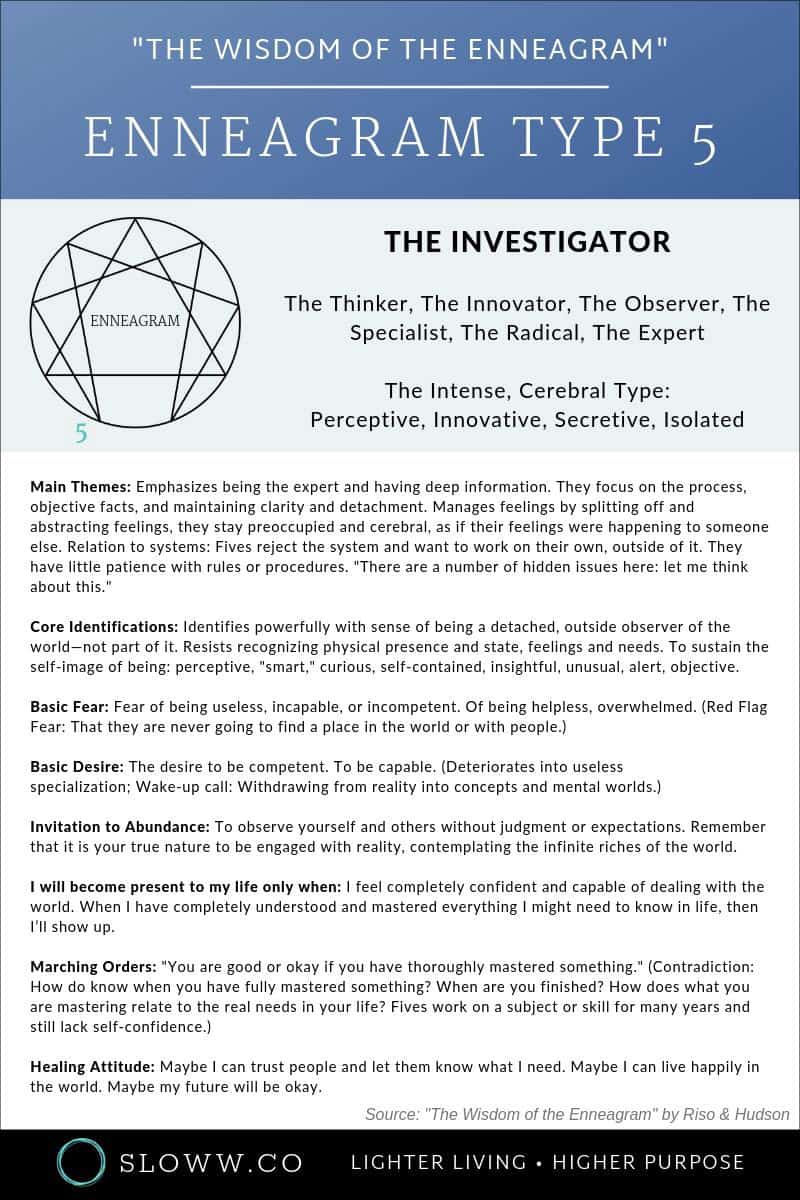
- The Thinker, The Innovator, The Observer, The Specialist, The Radical, The Expert
- The Intense, Cerebral Type: Perceptive, Innovative, Secretive, and Isolated
- More than any other type, Fives want to find out why things are the way they are. They want to understand how the world works, whether it is the cosmos, the microscopic world, the animal, vegetable, or mineral kingdom—or the inner world of their imaginations. They are always searching, asking questions, and delving into things in depth.
- Their belief is that from the safety of their minds, they will eventually figure out how to do things—and one day rejoin the world.
- Fives spend a lot of time observing and contemplating.
- Knowledge, understanding, and insight are thus highly valued by Fives, because their identity is built around having ideas and being someone who has something unusual and insightful to say.
- Fives have a niche for themselves that no one else occupies. They believe that developing this niche is the best way that they can attain independence and confidence.
- They therefore develop an intense focus on whatever they can master and feel secure about…they focus intensely on mastering something that has captured their interest.
- Much of their time gets spent collecting and developing ideas and skills they believe will make them feel confident and prepared.
- Fives do not expect anything from others, except to be left alone to pursue their own interests unimpeded by anyone else’s demands or needs, especially their emotional needs.
5w6: The Problem-Solver (Stephen Hawking, Bill Gates, Isaac Asimov, Amelia Earhart, Jane Goodall, Charles Darwin)
- Healthy: Observation combined with organization and detail gives people of this subtype the ability to draw meaningful conclusions from miscellaneous facts and to make predictions based on those conclusions. They seek a niche that will provide security and that fits into a larger context.
Enneagram Type 5 Self-Preservation Instinct:
- In the average range, Self-Preservation Fives attempt to gain independence and separation by reducing their needs. They are highly conscious of their energy expenditures, considering what activities and pursuits they will take on, and questioning whether they will have sufficient internal resources to meet them.
- Self-Preservation Fives are the true loners of the Enneagram, loving solitude and generally avoiding social contact.
- Often they will find ways to minimize their needs so that they can live on less money, thus avoiding interference with their independence and privacy.
Enneagram Type 5 Social Instinct: The Specialist
- In the average range, Social Fives engage with others and find a social niche for themselves through their knowledge and skill. They like to see themselves as Masters of Wisdom and want to become indispensable through their particular field of expertise.
- The most intellectual type of Five, Social Fives are often drawn to academics, science, and other forms of guruhood. They play the social role of the shaman, the wise person who lives at the edge of the tribe and brings back secret knowledge. Social Fives like to talk about weighty topics and complex theories, but they are generally uninterested in social banter.
Enneagram Type 5 Healthy Level 1 (Participating Visionary):
- Fives let go of the belief that they are separate from the environment—an outside observer—and are thus able to confidently engage in life. They also paradoxically achieve their Basic Desire—to be capable and competent and able to live in the world. They then become clear-minded, knowing, profound, and compassionate.
- Fives are among the least materialistic of the types and are happy with very few creature comforts.
- Fives are the most independent and idiosyncratic of the personality types.
- They attempt to maintain their independence by minimizing their needs. Their personal comforts can be simple to the point of being primitive. They live like “disembodied minds,” preoccupied with their theories and visions.
- The Fives main gifts to the world involve their tremendous insight and understanding, coupled with some area of expertise.
- Fives seem to have an extraordinary ability to concentrate and focus their attention, and they can do so for long periods of time.
- Focus and patience give them the ability to stay with projects long enough to mine gold from them.
- Because of their curiosity and open-mindedness, healthy Fives are highly innovative and inventive.
- Fives enjoy sharing their findings with others, and they often serve up their observations of life’s contradictions with a whimsical sense of humor.
- They like to provoke people into thinking more deeply about life and humor often serves as an excellent way of communicating ideas that would otherwise be too threatening.
- Fives face the same dilemma in their entire lives: they try to figure out how to live life without actually living it.
- The Fives drive for knowledge and mastery is the personality’s attempt to re-create an Essence quality that we might call clarity or inner knowing.
- Liberated Fives remember the spaciousness and clarity of the Divine Mind, what the Buddhists call “the shining Void,” or Sunyata, the quiet, undisturbed vastness from which everything arises, including all knowledge and creativity.
Enneagram Type 1 Summary: The Reformer
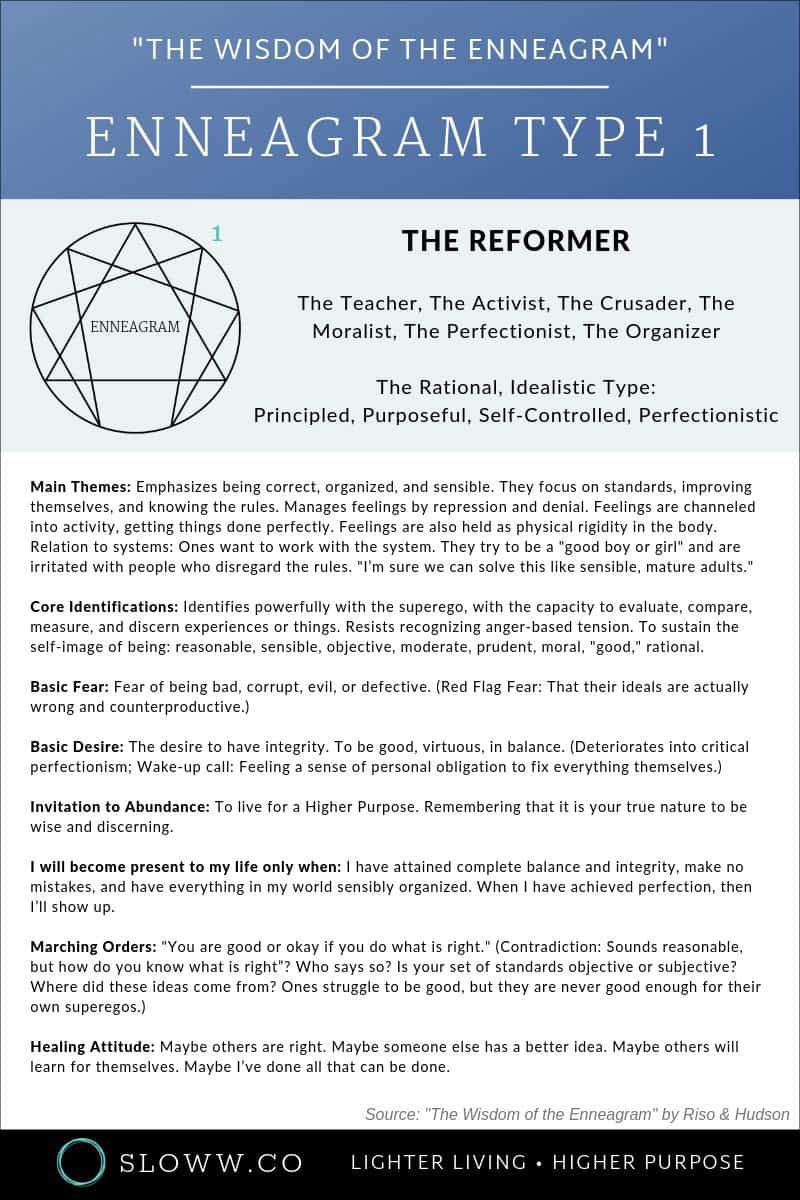
- The Teacher, The Activist, The Crusader, The Moralist, The Perfectionist, The Organizer
- The Rational, Idealistic Type: Principled, Purposeful, Self-Controlled, and Perfectionistic
- Ones have a sense of mission that leads them to want to improve the world in various ways, using whatever degree of influence they have.
- History is full of Ones who have left comfortable lives to do something extraordinary because they felt that something higher was calling them.
- Ones are people of practical action—they wish to be useful in the best sense of the word. On some level of consciousness, they feel that they “have a mission” to fulfill in life.
- Ones are actually activists who are searching for an acceptable rationale for what they feel they must do.
- Type One individuals also hold a boundary against the outside world, but they are far more invested in maintaining their internal boundary.
1w9: The Idealist (Plato, Gandhi, Henry David Thoreau, Noam Chomsky)
- Healthy: People of this subtype are highly discerning, wise, and civilized. They can be scholarly and erudite, maintaining a dispassionate philosophical stance that focuses on long-range concerns—the “big” picture. They can have an introverted, reclusive quality about them, seeking relief from “the maddening crowd,” often in quiet, natural settings.
Enneagram Type 1 Self-Preservation Instinct:
- In the average range, Self-Preservation Ones tend to worry about their material well-being, both in terms of finances and health, and they often castigate themselves for not working hard enough.
- …all-or-nothing attitude with regard to their pleasures and desires. They may either indulge themselves and their desires, or go through periods of asceticism, during which their desires are suppressed as much as possible.
Enneagram Type 1 Healthy Level 1 (Accepting Wise):
- Ones let go of the belief that they are in a position to judge anything objectively and are able to approach life without emotionally reacting to it. They also paradoxically achieve their Basic Desire—to have integrity and to be good. As a result of their self-actualization, they become wise, discerning, accepting, hopeful, and often noble.
- Healthy Ones are able to accomplish many of their objectives because they maintain a balanced self-discipline.
- Ones feel strongly that change is possible and that they want to be part of the solution.
- High-functioning Ones are a source of wisdom and discernment in an ambiguous world.
Have you read an Enneagram book or completed the test(s)? Please let me know your type and takeaways in the comments!
Continue Reading:
Personality meets Spirituality in “The Wisdom of the Enneagram” by Riso & Hudson (Book Summary)
The Stages of the Work from “The Wisdom of the Enneagram” (Short Story)




